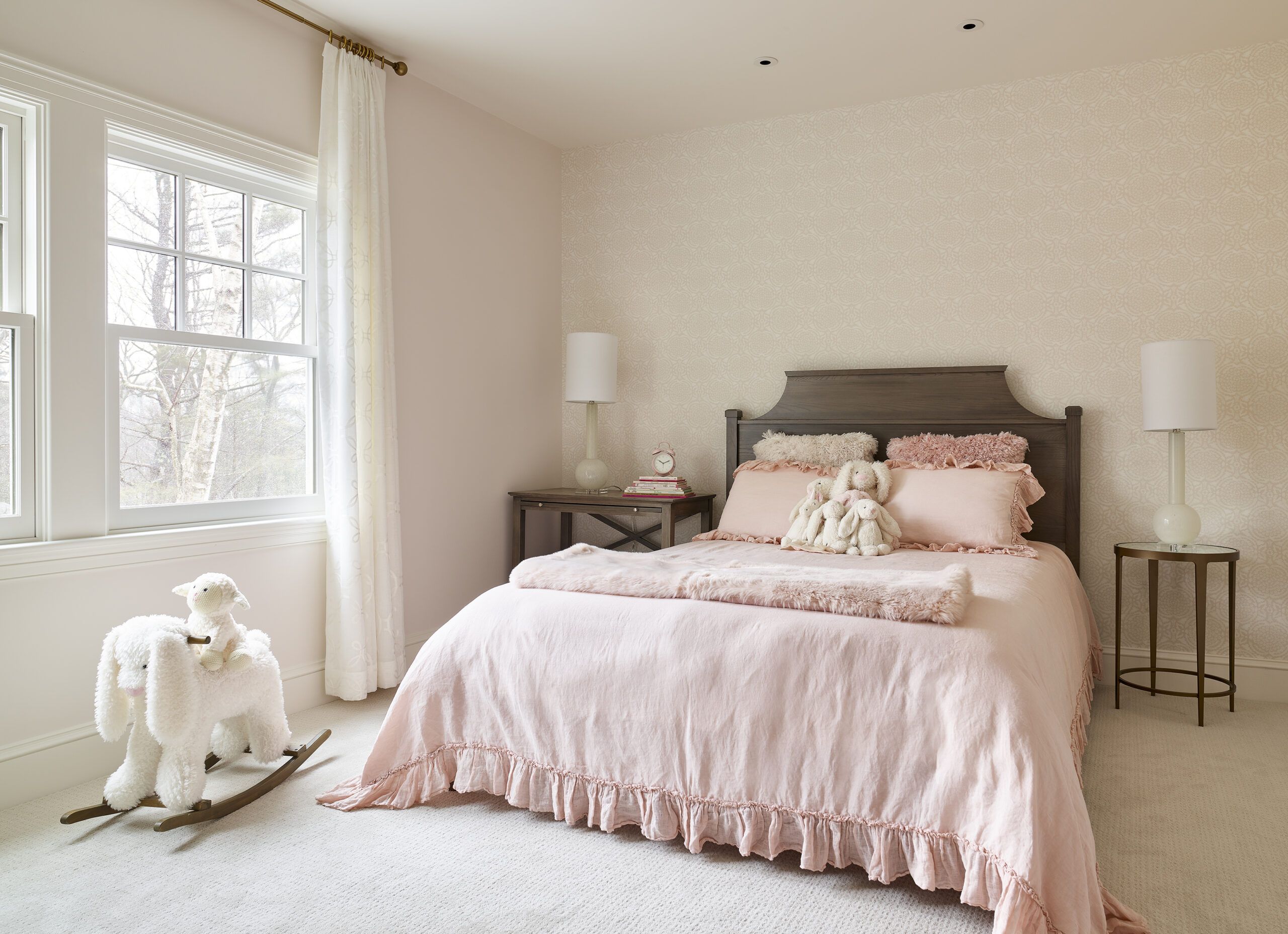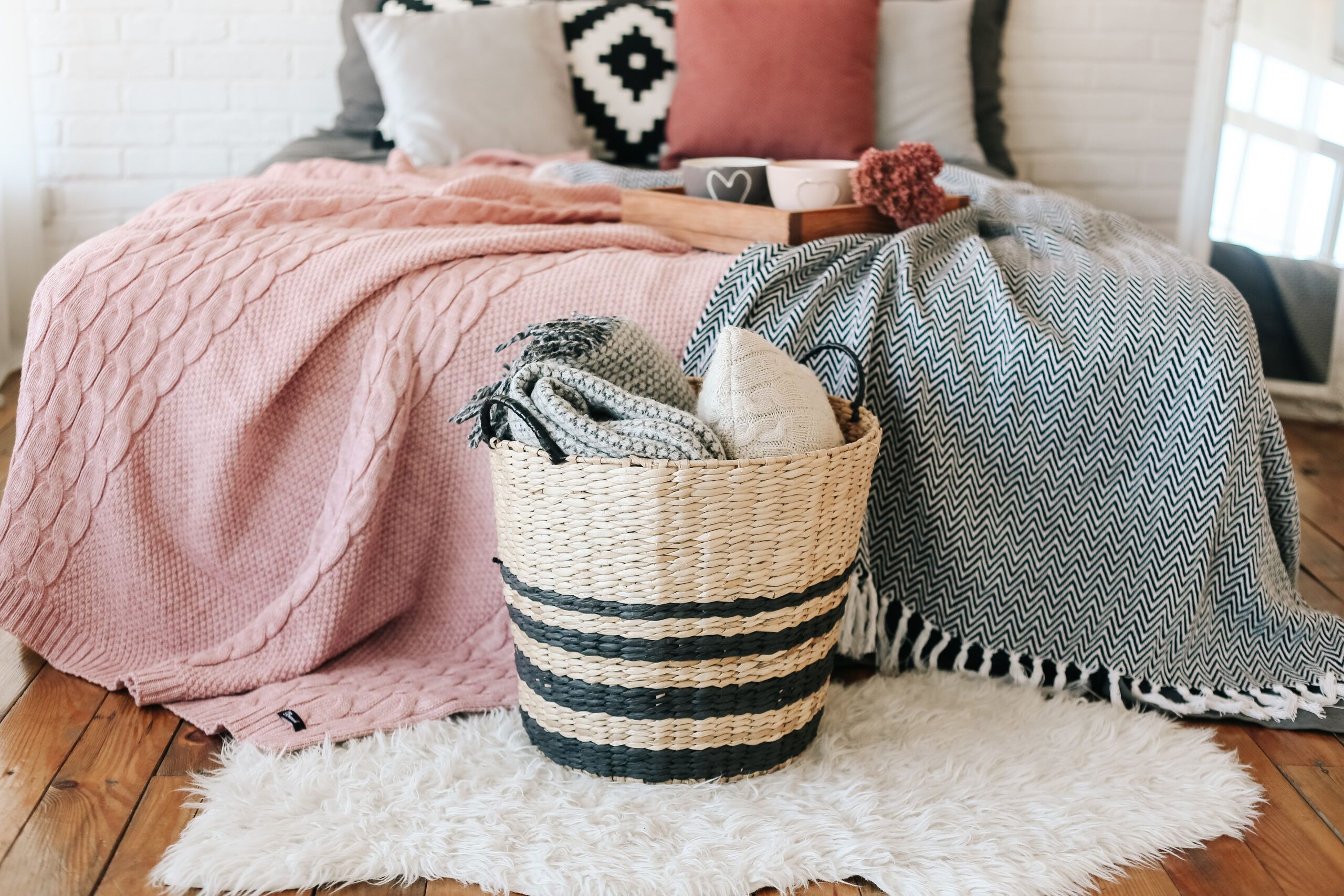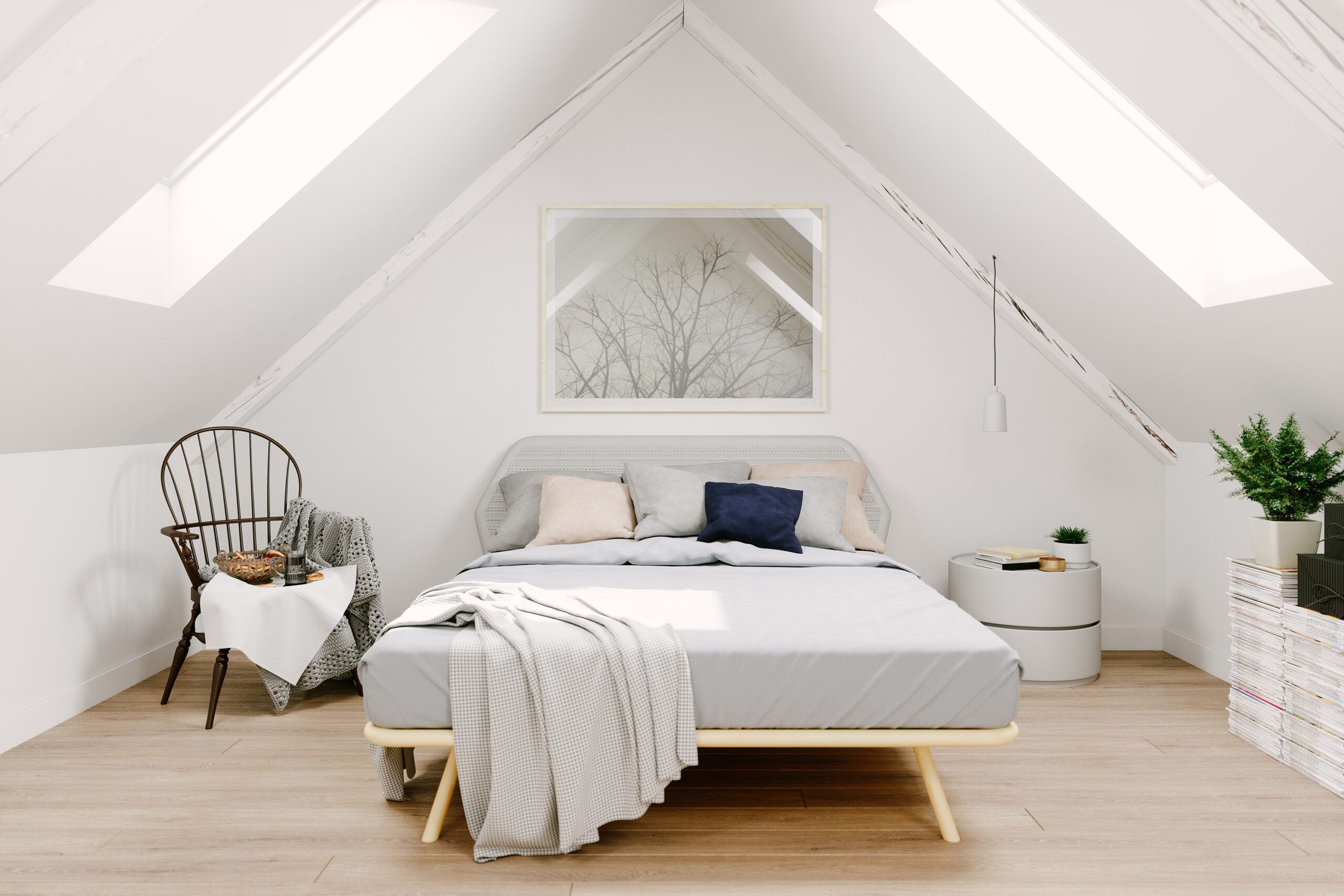There are plenty of designer tricks to make your small bedroom feel larger. If you feel cramped in your space, consider choosing more strategic colors, experimenting with lighting setups, or ditching your dresser completely. Learn how you can turn your compact bedroom into a cozy, spacious retreat in the guide below.
5 Steps to Make a Small Bedroom Look Bigger
Creating the illusion of space in a small bedroom is all about tricking the eye. You can make the area feel more open and comfortable with just a few clever design techniques.
1. Use Vertical Space
Maximizing vertical space is the key to making a small bedroom feel larger. Drawing the eye upward can create a feeling of height and openness.
Install shelves high on the walls, either above doorways or along the ceiling line, and hang artwork a little bit higher than you might normally. Choose floor-to-ceiling curtains instead of short drapes or blinds, which can make your ceilings appear taller. Finally, a tall, narrow bookcase can offer you more storage space without crowding the room.
2. Choose Colors Strategically

Color can completely change how spacious a room feels. Light, monochromatic color schemes can make small spaces appear larger, while softer shades of blue, green, or lavender can create a mood that is both calming and open. Neutral tones will amount to an airy feel.
Extend whichever color you choose to your ceiling to make the room feel taller. Match your curtains and headboard to the wall color for a cohesive look, which can visually expand the space. Add pops of color with throw pillows, artwork, or area rugs to keep the room from feeling too sterile.
3. Capitalize on the Lighting
Smart lighting can make a small bedroom feel more spacious. If your room lacks natural light, compensate with layered artificial lighting. Install a statement ceiling fixture, such as a chandelier or pendant light, to draw the eye upward. Complement this with wall sconces and table or floor lamps to eliminate dark corners and create a warm, inviting ambiance.
If the bedroom has windows, use sheer curtains during the day to maximize natural light while maintaining privacy. If you need to use blackout curtains for sleeping, consider layering them over sheers so you can easily adjust the light. Incorporating LED strip lights under shelves or around the room’s perimeter can also enhance the sense of space.
4. Choose Transparent Furnishings
Incorporating transparent or translucent furniture pieces into the bedroom can create an open feel. Consider clear lucite or glass furniture for items such as shelving units or bedside tables, and replace solid wooden doors with frosted glass alternatives. This allows light to filter through, which creates a sense of openness without sacrificing privacy. Experiment with acrylic chairs and tables alongside glass-topped desks to complete the space.
5. Add Mirrors to the Bedroom’s Walls
Mirrors can make a room appear larger by reflecting the space of a bedroom. They also elevate the room’s brightness by bouncing light around. Consider installing mirrored closet doors to visually double the room’s size. A large, floor-length mirror can create a similar effect, and also serves as a functional piece for dressing. If you want something subtler, add mirrored tiles to one wall, or use a collection of small mirrors as a decorative feature.
Strategically placing mirrors on opposite windows can maximize natural light and create the illusion of additional windows. Mirrored furniture such as dressers or bedside tables can add to the brighter, more spacious feel.
7 Tips for Organizing Small Bedroom
A space that’s organized feels larger, so start with decluttering. Be ruthless when deciding what you really need and use. Once you’ve pared down your belongings, consider the organization strategies below to successfully marry functionality and aesthetics.
1. Hide the Bed
The bed is the main feature of a bedroom, but it doesn’t have to be the point of visual focus, especially in a small space. Consider a Murphy bed that folds up against the wall when you’re not using it. Wall-mounted bed options can also incorporate shelving or desks. A cabinet bed can, alternatively, serve as both sleeping quarters and storage. For a multifunctional approach, choose a daybed that doubles as seating during waking hours.
2. Ditch the Dresser
Traditional dressers can take up a significant amount of floor space in a small bedroom. Address this with an alternative that maximizes storage but makes a room feel less cramped. A narrow chest of drawers, often called a highboy, takes up less space than a wide dresser, for example. Alternatively, you can eliminate the dresser completely and add closet storage that features shelving units and drawer systems. Use your nightstands for additional storage by choosing models with multiple drawers.
Store items that don’t require folding, such as socks, underwear, and pajamas, in decorative bins that you can keep under your bed.
3. Use the Space Under the Bed
The area under your bed is prime real estate for storage in a small bedroom. Make the most of this overlooked space with the following ideas:
- Create a custom storage solution with low, wheeled drawers that fit perfectly under your bed frame.
- Invest in a platform bed with built-in drawers for seamless, hidden storage.
- Store seasonal items, such as summer or winter clothes, to keep your closet from becoming overcrowded.
- Use bed risers to create space for storing large items or out-of-season clothing.
- Use rolling storage bins with lids to protect your items from dust and keep them accessible.
- Use vacuum-sealed bags for bulky items such as extra bedding or winter coats.
4. Use Baskets

Store extra blankets or pillows in large, decorative baskets. Baskets take up less space than traditional blanket chests and you can easily move them. Smaller matching baskets can hold accessories, toiletries, or reading materials. Use colorful baskets to organize toys in children’s rooms to make cleanup time easier and fun. Consider hanging baskets on the wall, too, to create additional storage without using floor space.
5. Hang Things on the Walls
Use wall space as storage to free up floor space in a small bedroom. Freeing up the floor can make a significant difference in how open a room feels.
- Construct shelving around the headboard in which you can store books and decor.
- Hang a fabric shoe organizer on the back of the door.
- Install a series of wall hooks on which you can hang items you frequently use, such as bags, jackets, or accessories.
- Install a wall-mounted desk that you can tuck away when you’re not using it.
- Mount floating shelves to display books, plants, or decorative items.
- Use a pegboard system for flexible, customizable storage of small items.
6. Get a new Headboard
Invest in a headboard that features built-in storage, shelves, or cubbies. These types of headboards can eliminate the need for bedside tables, which frees up floor space. Look for designs that feature integrated lighting options, such as sconces or reading lights, to save space on table lamps. If you prefer a minimalist look, consider a slim, wall-mounted headboard, which can add a decorative touch without taking up any floor space.
7. Build or Buy a Jewelry Cabinet
Storing jewelry can be difficult in a small bedroom, and a wall-mounted jewelry cabinet offers an elegant solution. Choose a cabinet that features a full-length mirror on the front, and hang it on the wall, over a door, or between studs for a sleek, built-in look. If you don’t have an extensive jewelry collection, use the cabinet to store other small items such as accessories, toiletries, or medications. Some models even come with built-in lights, which makes it easier to find whatever you’re looking for.
Our Conclusion
You can turn your small bedroom into a spacious, organized retreat with the right strategies. Use vertical space, choose colors wisely, and implement smart storage solutions to create an area that feels much bigger than it is.

